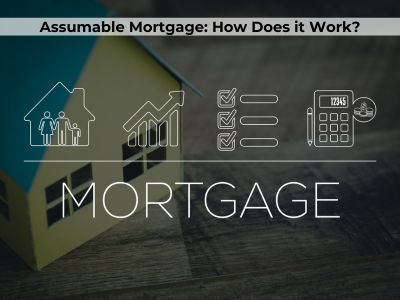Purchasing a home is a long-time financial commitment as it is one of the most significant investments you’ll ever make. There are various mortgage options available in the market. One of these is an assumable mortgage. In this article, we will discuss further what is an assumable mortgage and how it will benefit you.
What is Assumable Mortgage?
An assumable mortgage is a type of mortgage that allows the buyer to take over the existing mortgage of the seller. Instead of taking out a new mortgage, they assume the seller’s mortgage and continue to make the same payments.
The buyer should qualify for a loan just like how they qualify for a traditional mortgage. Also, the lender may charge a fee for processing assumptions.
How Does Assumable Mortgage Work?
When the buyer takes over the existing mortgage, they assume responsibility for paying it. The terms will remain the same, including the interest rate and payment amount. The buyer should qualify for a loan, just as they should be in other mortgages.
Benefits of Assumable Mortgage:
- Lower Interest Rates. If the interest has gone up since they took the mortgage, an assumable mortgage is a good choice since you can continue with payments with the same lower interest rates. By assuming the seller’s mortgage, you can lock in a lower interest rate than is currently available.
- Lower Closing Costs. You, as the buyer, will be taking over an existing mortgage from the seller and may not need to pay for closing costs like loan origination fees.
- Easier Qualification. Assuming an existing mortgage may be the best option for you if you do not qualify for a traditional mortgage. Buyers with low credit scores or doesn’t meet lender’s criteria may be able to qualify for assumable mortgages.
- Attractive to Potential Buyers. An assumable mortgage can make your home more attractive to potential buyers if you are a seller. Your lower interest rate may be appealing to buyers.
Drawbacks of an Assumable Mortgage:
Along with the benefits, there are still possible drawbacks that come along with an assumable mortgage, including:
- Higher Purchase Price. Some sellers may set a higher purchasing price because they are essentially paying for the convenience of taking over the seller’s mortgage.
- Limited Options. An assumable mortgage is rare in Canada, so there’s a higher possibility that fewer options may be available in the market.
- Less Favourable Terms. The terms of the existing mortgage may not be as favourable as what the buyer could get with a new mortgage. For instance, the interest rates decreased since the seller took out their mortgage, so you may not be able to get a lower interest.
- Additional Fees. The lender may charge a fee for processing the assumption, which can add to the mortgage cost.
How to Negotiate an Assumable Mortgage?
There are a few things that buyers and sellers should consider before negotiating an assumable mortgage. These include:
- Determine the value of the property.
The buyer and seller should agree on the property’s value. This will help determine a fair price for the mortgage.
- Understand the terms of the mortgage.
Just like in any other mortgage, buyers should know and understand the mortgage terms. To avoid conflict, you should understand the interest rates, payment schedule, and any prepayment penalties.
- Negotiate the terms of the mortgage.
Once the value of the property and the mortgage terms have been established, the buyer and seller can negotiate the terms of the assumable mortgage. This may include adjusting the interest rate, payment schedule, or other terms to better suit the needs of both parties.
- Hire a real estate lawyer.
it is recommended that both parties have real estate lawyers to help with the review and finalization of the terms of the assumable mortgage. This can help ensure that the transaction is legally binding and that both parties are protected.
- Consider other financing options.
If the terms are unfavorable or the buyer cannot qualify for the mortgage, it may be necessary to consider other financing options. It can be a traditional mortgage or a private lender.
Alternatives to Assumable Mortgage
If you feel like an assumable mortgage has unfavorable terms, or if you are unable to qualify, there are several alternatives you can use to obtain a mortgage. These include:
- Conventional Mortgage
A traditional mortgage not insured by the Canada Mortgage and Housing Corporation (CMHC) or other government agencies. These mortgages typically require a down payment of at least 20% of the purchase price and can offer more flexibility in payment schedules and prepayment options.
- High Ratio Mortgages
A mortgage that requires a down payment of less than 20% of the purchase price. These mortgages are insured by CMHC. Best choice for borrowers who cannot provide a large down payment.
- Home Equity Lines of Credit (HELOCs)
A home equity line of credit is a revolving credit secured by the equity in a home. Homeowners can borrow against the equity in their home up to a certain limit and use the funds for home renovations, debt consolidation, or other purposes.
- Private Mortgages
It is a type of mortgage financed by an individual or a group of investors rather than traditional lenders. They have flexible terms and are easier to qualify for but have higher interest rates.
- Rent-to-own Agreements
A contract between buyer and seller in which the buyer agrees to rent the property for a set period with the option to purchase the property at the end of the rental period.
Conclusion:
Assumable mortgages in Canada can benefit buyers and sellers, such as lower interest rates and easier qualification. However, there are also drawbacks, such as limited availability and potential liability for the seller. Ultimately, the best financing option will depend on the individual financial situation and the home buyer’s or seller’s goals.




